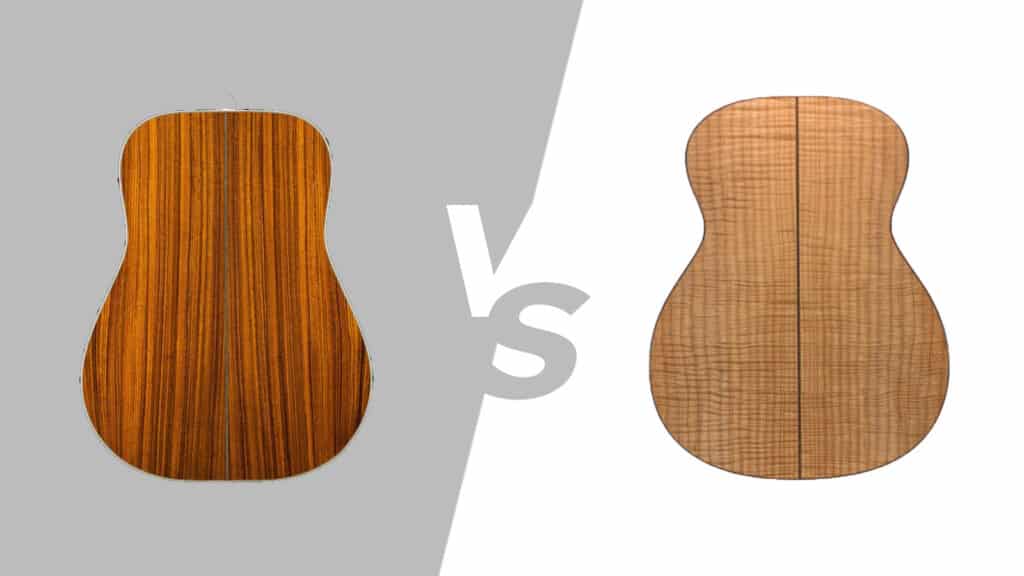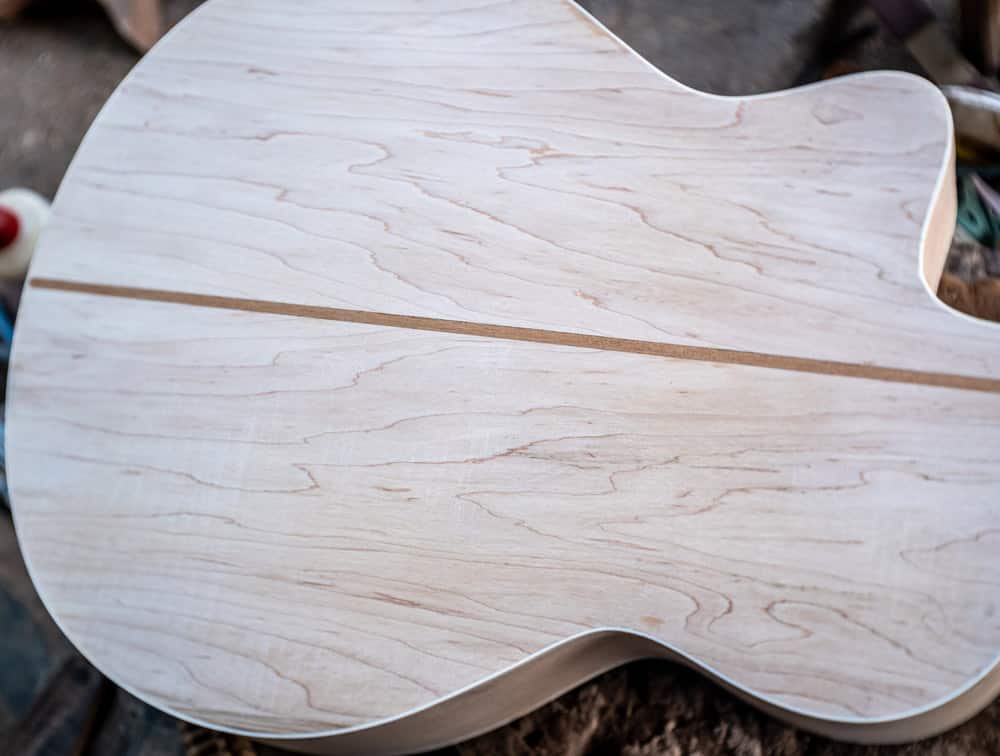
In the past, there was no specification of the wood, and the stringed instruments were made of stone and metal. With the passage of time, several advancements were made in the field of music, and wood was used to make musical instruments. If you look around, you will see that most guitars are made out of wood.
Features like perfect insulation, echo, and better resonance justify the use of wood in the manufacturing of guitars. The ergonomic nature of wooden guitars makes them a far better choice for most musicians. Carry it around your shoulder anywhere without any fatigue.
You can keep playing your guitar for as long as you want, thanks to the comfortable posture that it provides. The market is replete with a number of wooden guitars varying on the grounds of wood types. Every wood type used in the guitar has its own tone and style, and it meets the needs of the artist in its own way.
Pau Ferro and Maple stand out from the rest about the most common wood types used for guitars.
Pau Ferro Vs. Maple Overview
Comparison Between Pau Ferro And Maple
| Features | Pau Ferro | Maple |
|---|---|---|
| Hardwood/Softwood | Hardwood | Hardwood |
| Color | Dark brown to reddish | Golden to reddish brown |
| Grain | Straight, irregular | Straight or wavy |
| Texture | Even | Even |
| Density | 865 kg/m3 / 54.0 lb/ft3 | 530 kg/m3 / 33.1 lb/ft3 |
| Hardness | 8,710 N / 1,960 lbf | 3,110 N / 700 lbf |
| Elastic Modulus | 10.86 GPa / 1,575,000 psi | 7.86 GPa / 1,140,000 psi |
| Tone | Warm | Bright |
| Price | Moderate | Moderate |
Pau Ferro
The wood type of Pau Ferro is commonly found in South America. It has two shades, a dark shade and a darker one. The hard density of the Pau Ferro lets you have a firm posture on the fingerboard. The perfect installation of the frets on the board saves you from all kinds of troubles regarding instability.
Pau Ferro doesn’t resonate with it if you have accidentally touched a string. The absorption of small frequencies by Pau Ferro makes it a much more suitable choice for the guitar fingerboard. Initially used as an alternative for Rosewood, Pau Ferro has far more versatile grain patterns and color variations.
It has a uniform density like no other wood. Pau Ferro has got the looks of Rosewood and a warmer tone than Maple. It can be an excellent feature of the guitar if it is used on the guitar fingerboard and fretboard. You might have to encounter some challenges while gluing it because of its oily nature.
Pau Ferro doesn’t require a finish. It is appropriate to use as soon as it is dry. Pau Ferro gives you a warm tone that also carries an articulate attack. Usually, it is common in fretboards and backs and sides of acoustic guitars. However, its heavyweight prevents its use in the necks and solid bodies.
Pau Ferro adds a warm touch in the low end. It is pronounced and properly defined if you ask about its high end. The response of sound resulting from the Ferro tonewood is as clear as it can get.
Maple
Maple is one of the most widely used wood types in guitars. Maple can give the most results if used for the body of a guitar. Get ready to have a soft, resonating, and comforting playing experience with Maple. It gives a unique and accurate touch to the sound. The tones produced from Maple are very fine and clean.
As far as the sound produced by Maple is concerned, it is crispy, bright, and well defined. The density and strength of Maple as a tonewood are matchless. Most of the Fender guitars are made of maple wood. Unlike Pau Ferro, Maple does require a finish to keep itself from the harm of humidity.
The color range of Maple tonewood varies from white to golden shades. With Maple, you are promised good resonance and a richly defined top end. The flexibility and durability of Maple are yet another astonishing feature of this tonewood.
The best thing about Maple is that it can take a little bit of beating and let you take it out anywhere out there.
Comparison Between Pau Ferro And Maple
The sound coming out of a Maple guitar is bright and smoothly cuts through the mix. On the other hand, Pau Ferro has warm and fulfilling vibes. In addition, there are more differences between the two of these tonewoods.
Appearance
When you set a comparison between Pau Ferro and Maple on an aesthetic basis, it solely depends on your personal taste. Pau Ferro resembles Rosewood with a reddish hue. When you are holding a Pau Ferro guitar, you get a natural feel of wholesomeness.
Talking about the fingerboards of the Pau Ferro, some of them don’t have a finish while others have a thin finish. This wood can last years, but you can oil it for more protection. You can stain the Ferro fretboards with the color of your choice; there is no match to its natural color.
Maple wood is light in color. There are plenty of finish options for its fretboards. If not, you can treat the wood because nobody wants to play a torn-out, grimy-looking guitar after some years. A light tint gloss finish can give a natural look to this tonewood.
If you want to have a darker maple fretboard, flame roasting will add character to it.
Tonal Differences
One cannot choose a particular wood type without knowing its effect on the guitar’s tone. The sound coming out of a Pau Ferro has an elastic tone that is very catchy and appealing. Usually, the note-to-note contrast is tense for some ears, but that’s not the case with Pau Ferro. The low end has robust sounds.
Maple promises more defined and brighter sounds with strong upper mids. The hardness of Maple is directly related to the brightness of the tone. The overtones resulting from Maple are sharp, and the decay is fast.
If one had to sum up Maple in one sentence, it would be loud projection, quick decay, bright tone, balanced bass, and strong mids.
Feel
Feel is the most important factor when you have to choose between two tonewoods. Holding a Pau Ferro guitar gives you a smooth and enriching feel of the wood. With a little friction, you are set for an effortless soloing. The ease of play is potentially enhanced if you have a Pau Ferro tonewood.
The feel of a Maple tonewood is highly dependent on the fact that it has a finish or not. There is more convenience and polish while playing an unfinished tonewood. On the other hand, you can feel the stickiness with a glossed finish on maple tonewood.
Another disturbing detail includes the too much friction, which lags the playing of the guitar.
Conclusion
The decision for a particular tonewood is related to one’s personal taste. People who want Pau Ferro would be very particular about its tone, feel, and appearance. The same goes for the Maple lovers. However, if you value the feel of a guitar, go for a Pau Ferro.
People who are looking for brighter and clear sounds from the guitar should pick Maple.


